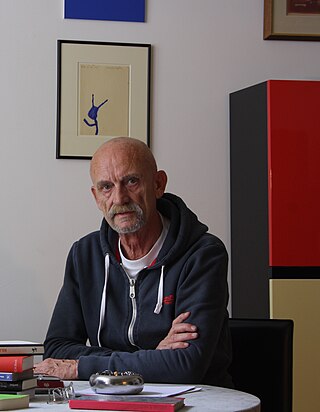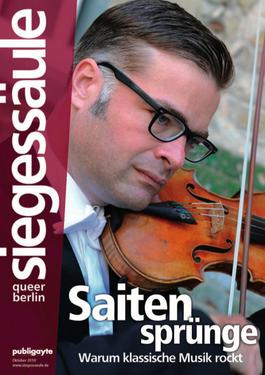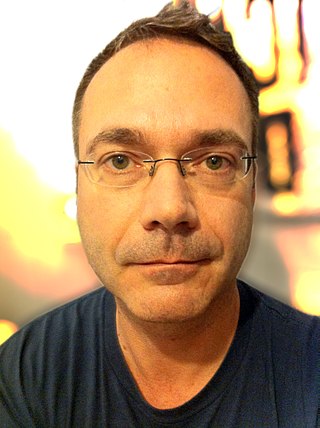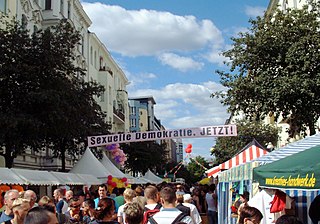Hermann Ludwig Gremliza was a German radical left journalist.

OutWeek was a gay and lesbian weekly news magazine published in New York City from 1989 to 1991. During its two-year existence, OutWeek was widely considered the leading voice of AIDS activism and the initiator of a cool new sensibility in lesbian and gay journalism.
The Felix-Rexhausen Award were created 1998 by the Bund Lesbischer und Schwuler JournalistInnen to recognize and honor the mainstream media for their fair, accurate and inclusive representations of the LGBT community and the issues that affect their lives.

Martin Dannecker is a German sexologist and author.

Siegessäule is Berlin's most widely distributed queer magazine and has been published monthly, except for two brief hiatuses, since April 1984. Originally only available in West Berlin, it ran with the subtitle "Berlin's monthly page for Gays". In 1996, it was broadened to include lesbian content, and in 2005 it was expanded to reach a wider queer target base, becoming the only magazine of its scale in Europe to represent the full spectrum of the LGBT community. The magazine is available for free at around 700 locations in Berlin, printing 53.688 copies per month. Since March-issue 2013, it has been overseen by chief editor Jan Noll.

Reimar Oltmanns is a well-known journalist and author in Germany.
Axel Schock is a German journalist and author.

The Schwules Museum in Berlin, Germany, is a museum and research centre with collections focusing on LGBTQ+ history and culture. It opened in 1985 and it was the first museum in the world dedicated to gay history.

Christian Scheuß is a German author and journalist.

Manuela Kay is a German journalist, author and publisher.

Hermann J. Huber was a German journalist and writer. He was born in Moosbach.
Centrum Schwule Geschichte e. V., abbreviated CSG, is a German "LGBT" organization based in Cologne (Köln).

Die Freundin was a popular Weimar-era German lesbian magazine published from 1924 to 1933. Founded in 1924, it was the world's first lesbian magazine, closely followed by Frauenliebe and Die BIF. The magazine was published from Berlin, the capital of Germany, by the Bund für Menschenrecht, run by gay activist and publisher Friedrich Radszuweit. The Bund was an organization for homosexuals which had a membership of 48,000 in the 1920s.

Jerry Douglas was an American film director and screenwriter, notably of gay pornographic films, as well as a novelist, playwright, and theatre director. He wrote and directed the play Tubstrip, which appeared on Broadway in 1974, starring Casey Donovan. His cinematic work won numerous adult film industry awards, and he was inducted into the Grabby Awards Hall of Fame and the GayVN Awards Hall of Fame.

Berlin was the capital city of the German Empire from 1871 to 1945, its eastern part the de facto capital of East Germany from 1949 to 1990, and has been the capital of the unified Federal Republic of Germany since June, 1991. The city has an active LGBT community with a long history. Berlin has many LGBTIQ+ friendly districts, though the borough of Schöneberg is widely viewed both locally and by visitors as Berlin's gayborhood. Particularly the boroughs North-West near Nollendorfplatz identifies as Berlin's "Regenbogenkiez", with a certain concentration of gay bars near and along Motzstraße and Fuggerstraße. Many of the decisive events of what has become known as Germany's second LGBT movement take place in the West Berlin boroughs of Charlottenburg, Schöneberg, and Kreuzberg beginning in 1971 with the formation of the Homosexuelle Aktion Westberlin (HAW). Where as in East Berlin the district of Prenzlauer Berg became synonymous with the East Germany LGBT movement beginning in 1973 with the founding of the HIB. Schöneberg's gayborhood has a lot to offer for locals and tourists alike, and caters to, and is particularly popular with gay men. Berlin's large LGBT events such as the Lesbian and Gay City Festival, East Berlin Leather and Fetish Week, Folsom Europe, and CSD center around Schöneberg, with related events taking place city-wide during these events. Nevertheless, with roughly 180 years of LGBTIQ+ history, and a very large community made up of members with very varied biographies, it is hard to find a place in Berlin completely without LGBT culture past or present. Berlin's present-day neighborhoods with a certain concentration of LGBTIQ+ oriented culture vary somewhat in terms of history, demography, and where the emphasis in each neighborhoods' queer culture falls along the LGBTIQ+ spectrum. Over the course of its nearly two centuries of queer history (herstory), definitions not with standing, Berlin's LGBTIQ+ culture has never ceased to change, not only in appearance and self-understanding, but also in where the centers of queer culture were located in the city. What is true about Berlin's "LGBT culture in Berlin" at one point in time, in a given place and from a given perspective, is almost certainly different the next.
The following is a timeline of lesbian, gay, bisexual, transgender and queer (LGBTQ) journalism history.
The Kölnische Rundschau is a regional, independent daily newspaper for the Cologne/Bonn area. It is edited by Cologne Heinen-Verlag, which has its own independent local editorial office. The production of the national section was taken over by the Bonn General-Anzeiger during the first quarter of 2010. In the first quarter of 2018, the joint edition with the Kölner Stadt-Anzeiger sold 251,994 copies, a loss of 40% since 1999.
Leonard Fink (1930–1992) was an American photographer who documented his own LGBT culture in New York City from 1967 to 1992. He photographed the annual Pride Marches beginning with the first in 1970; the West Village's gay bar culture; and in particular the abandoned West Side piers where men cruised and had sexual encounters.

The Eldorado was the name of multiple nightclubs and performance venues in Berlin before the Nazi era and World War II. The name of the cabaret Eldorado has become an integral part of the popular iconography of what has come to be seen as the culture of the period in German history often referred to as the "Weimar Republic". Two of the five locations the club occupied in its history are known to have catered to a gay crowd, though the phrase gay bar, which could conjure up images of the type of bar that became common after World War II catering first and foremost to gay and lesbian clientele, does not accurately describe what an establishment like Eldorado to a certain extent was, and what similar venues still are to this day.












